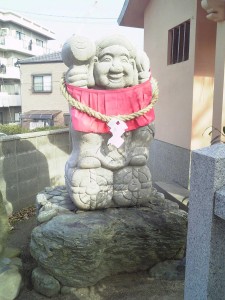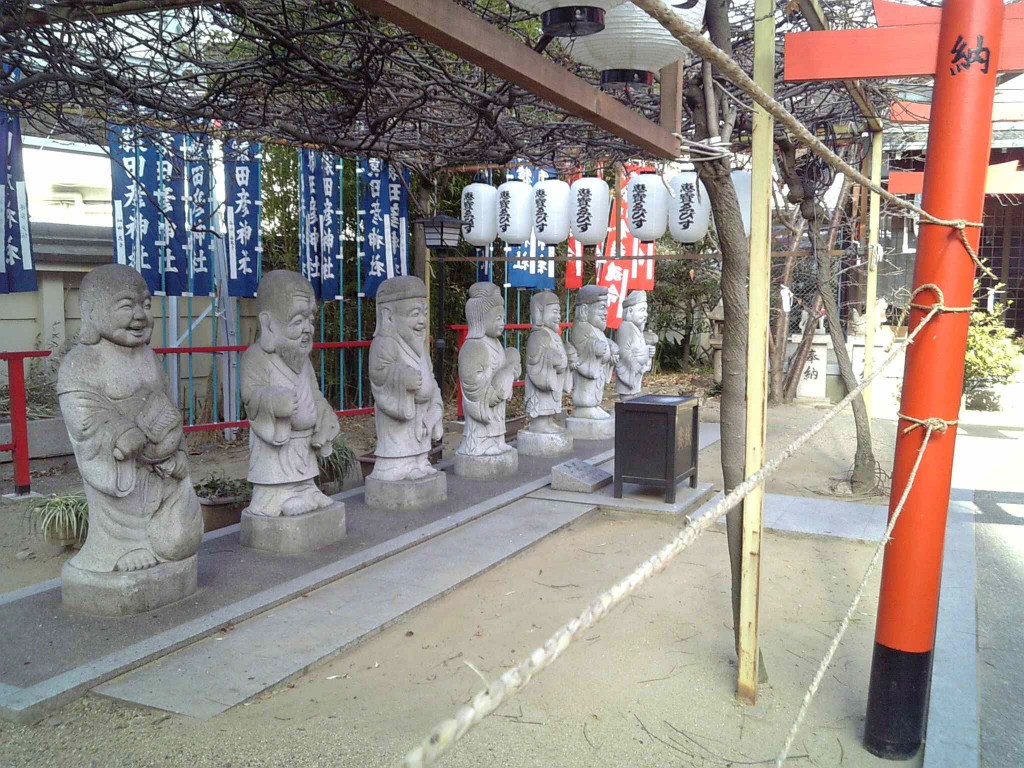
A happy looking Daikoku, perhaps the most popular of the gods and one who doubles as the kami Okuninushi because of having the same kanji.
Green Shinto friend, Paul Carty, has written in with information taken from the Seven Lucky Gods of Japan by Reiko Chiba (Tuttle, 1966). It’s a short book which looks at the origins.
The first recorded mention apparently is 1420 in Fushimi (in modern-day Kyoto), where some kind of procession of the gods was held in imitation of a daimyo procession. Then in the 1470-1480 period, bandits dressed up as the gods and tricked people into giving them money!
The key event was a conversation that took place in 1620 between Iemitsu and Tenkai, a top Tendai monk. Tenkai said there were seven qualities of nobility, which are the possessions of one who is god-like. (Iemitsu was much concerned with the deification of his grandfather, Tokugawa Ieyasu.) The qualities were as follows: longevity, fortune, popularity, candor, amiability, dignity and magnanimity.
Iemitsu liked Tenkai’s theory and asked the monk to pick seven gods who typified the qualities, then gave his authority to institute and formalise their worship. This was duly carried out and Tenkai commissioned one of the top Kano artists to paint the seven gods.
(N.B. Mark Schumacher’s website gives some alternative suggestions to this narrative at this link. He also explores the human fascination with ‘lucky seven’, attributing this to the seven-star Big Dipper and the seven planets visible in ancient times, though personally I would have thought the seven days in the moon’s quarter was a decisive factor. It’s why we have the seven-day week, after all.)

The Seven Lucky Gods lined up at Tarumi Jinja near Kobe
***************
For those visiting Kyoto, it may be of interest to note that Japan’s oldest Seven Lucky Deities pilgrimage consists of the following places. (Interestingly, only one of them is a shrine.)

Thank you Lord Dougill for referring to to my web page:
http://www.onmarkproductions.com/html/seven.shtml
Art historian Patricia Graham, p. 112 says in her book Faith and Power in Japanese Buddhist Art, 1600-2005: “Twentieth-century sources credit the priest Tenkai, Ieyasu’s advisor, with concocting the grouping [of Seven Lucky Gods] for the edification of the third shogun, Tokugawa Iemitsu. These sources explain that Tenkai identified the individual gods with seven virtues (longevity, fortune, popularity, candor, amiability, dignity, magnanimity) that kings impart to their subjects if they [the kings] follow the teachings of the Sutra of the Benevolent Kings (Ninnō-kyō 仁王經). However, Tenkai’s known writings and Rinnōji Temple 輪王寺 records [where Tenkai was active] make no mention of the Seven Gods.”
This, it seems, discredits the view presented by Reiko Chiba (Tuttle, 1966) that you mention in this post. Reiko Chiba’s book is quite fun and informative, and I heartily recommend it. But I myself agree with Graham. Chiba and others have been misinformed. The story of the monk Tenkai is most likely false and concocted. Louis Frederic, in his Buddhism Flammarian Iconographic Guide, also tells the same story as Chiba — but neither author gives any real “source” for their information, which I suggest is false.
sincerely,
mark in kamakura